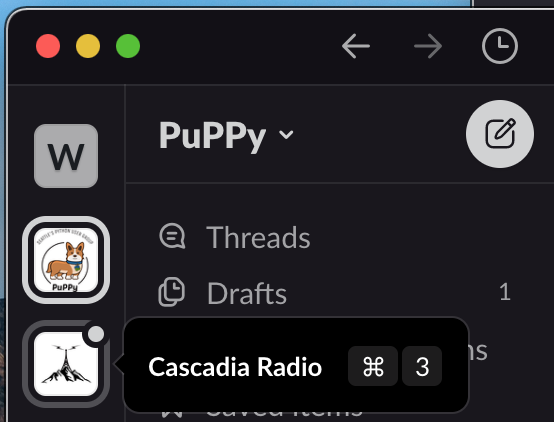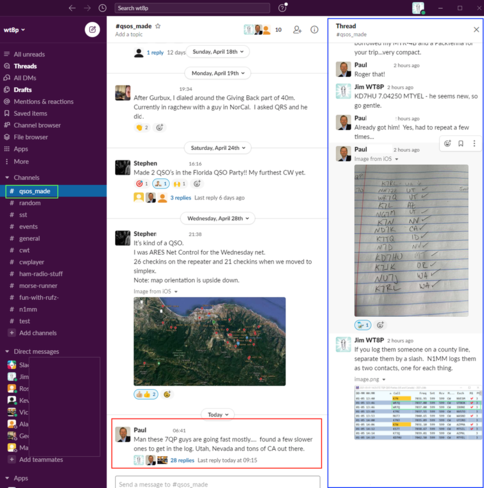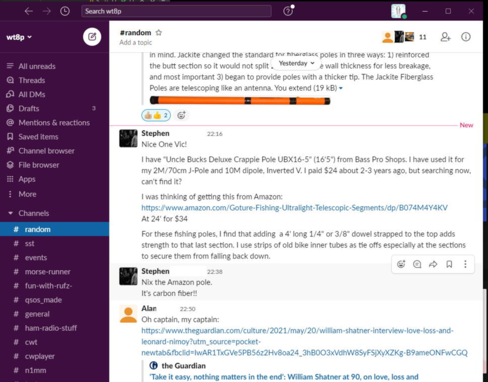During the latter part of my Basic class, when students were becoming more engaged, we ran into several problems with the email and text messaging. As an experiment, we used Slack in my intermediate class the most recent term. Feedback was overwhelmingly positive. In the spirit of trying to give back, I thought it would be helpful relating our experience.
73, Jim WT8P
Email works for some specific situations such as contacting the entire class and sharing detailed information. There were occasions where my missives were too long and detailed. Some email clients (e.g., Outlook) make it difficult to find messages. Email is poor for any real-time event, such as a student who was on the air right now and looking for contacts.
Text messaging is better for real-time events and a single topic. Once the recipient list got to be more than a few people, an attachment was needed or anyone was not up on the most recent message, it fell apart because text messaging lacks threading. Moreover, there is no option to temporarily mute. The flurry interfered with other, more important texts (family, work)
What is Slack?
It is channel-based messaging tool often used by software teams to communicate. One sets up a workspace that individuals subscribe to. (One can subscribe to multiple workspaces, maintaining separate profiles for each. For example, I am part of the PuPPy — python programmers — but don’t show my call sign since it would be confusing to them.

Within that workspace are “Channels” are like hashtags for major subject areas. One can subscribe or browse channels as desired and, optionally, create new ones. It works on android, iOS, Windows, Mac, and any modern browser. I find it convenient to run the local app in the background. If I have time, I can respond to questions quickly.
We set up channels for:
#events – is where I post most of my class material like the upcoming assignments or CW events they may want to try. As several of us were going back to work full-time, I tried to maintain a week’s worth of activities in advance so people could work it into their schedules.

#sst, #cwt – K1USN’s SST and CWOPS’ CWT are two of the regular practice events that are geared towards new hams. CWT is more aggressively-paced, introduced towards the end of the Intermediate class.

#qsos_made – a place to discuss QSOs, specifically actively seeking one or “brag” that they made one and offer encouragement to others doing the same. There are abundant emoji options that add some levity. Topics are naturally threaded. For example, during 7QP (7th area QSO party), there was a lot of activity as half of the students are in that area. A subset of the thread (red box) appears on the right navigation (blue box).

#morse-runner, #n1mm, #cwplayer, #fun-with-rufz-xp – these are dedicated to the specific tools Morse Runner (simple contest practicing), N1MM+ (contest logging on Windows), CW Player (general practice tool) and RufzXP. If I advise the advanced class, I will likely introduce G4FON’s contest trainer.
#random – everything else.

Consensus is it worked very well for our specific needs.
- We initially had some initial hiccups with people posting replies as a new message versus using the reply feature until the icon was pointed out
- Emoji have been exceedingly popular for quick responses to messages.
- Posting links, images and attachments is very easy.
- We added channels for the tools (N1MM, CWPlayer and Morse Runner) once there were enough discussions to merit another. At one point, I also posted links to YouTube tutorials I made on using N1MM for CWT and using Morse Runner and slack was smart enough to embed them.
- There is an add-in for calendaring, or you can link Google Calendar, which provided a list of the various on-air opportunities.
- Separately, I had a Dropbox share with a collection of supplementary materials, including the Wordsworth audio files that John (AJ1DM) produced from the Intermediate Stories, downloads of CWPlayer, RufzXP & Morse Runner, and a list of CWOps call signs. I linked my Dropbox share to Slack and post direct links that way. (Wordsworth is a concept from George (K1IG) where words are sent at full rate, but spacing between words is typical of what you’d expect in Farnsworth. The result is you can focus on learning how entire words “sound” rather than piecing together the letters.)
- Messages can easily muted by thread, person (not really applicable for CWA), or for a specific, temporary time (such as when I’m working on month-end financial reporting). This has made real-time events such as SST/CWT, students looking for on-air contacts, or SOTA activations more tolerable.
- The free version of Slack (that we are using) includes 10,000 messages and unlimited users. Since March, the 9 of us have posted 1900 messages. When we hit the message limit, the oldest ones roll off, so it seems fine for things that are transient (like QSOs!).
Why Slack and not _____? I did not have a lot of time between classes to set up, learn and configure tools. I chose Slack over the alternatives (see below) because I’m familiar with it from prior organizations and its use during Comm Academy and Parks on the Air. Some alternatives of note:
- Telegram (telegram.org) – On paper, this tool looks excellent, possibly even better than Slack. It’s worth looking at.
- Discord (discord.com) – The online VEs use this tool, but the handful of times I tried it, I found it baffling.
- Groups.io – it has threading and an option to selectively mute topics. While one can also mute by hashtag, it requires people to use them. I have seen these used on SKCC, but few of the other groups (K4, CWops, LICW, …). Groups.io is heavily dependent upon email. Delivery options are limited to everything (not muted), a dozen at a time, once a day, special messages, or none. If subgroups are implemented, you can have different frequencies.
- Zoom – I have a paid account for my CWA sessions. It is not really set up to do chats or (without spending more) delegating rooms for ad hoc conversations.
Questions that have come up:
To do the type of stuff that I would like to with Slack, I need 100% buy-in. I can’t have five of my students on Slack and one sticking with email, only. For advisors, it would be the same. It could be more work to maintain two communication channels (email and Slack).
That is a fair point. Because I am comfortable enough with the technology (and administering my own group), I was a heavy-handed with “this is what we’re doing” to kick it off last term. I’d send them a link that they’d click on to activate their profile. One student had some general privacy concerns that we addressed by using a disposable email address to sign up for Slack. If any CWA advisors want to give it a shot and have questions, you’re welcome to contact me offline and I’ll try to help.
Some students (not just from my classes) have asked for a channel, other than Facebook, to stay in touch with their classmates and other students from similar classes after a class is over.
Sharing tips and successes in real-time has been a boon. Having a channel not tied to a major social media platform has helped keep it friendly and focused on ham/CW (because we can keep our own personal lives and biases out of the conversation). Although the summer hiatus has put a damper on activity, several folks have been posting about the 13 colonies event, trying to find the elusive GB13COL on CW.
I am also getting requests for something that all intermediate or advanced students, or just post-class students in general, can use and wonder how to handle that? If we have 20 advisors, each with their own Slack accounts, do we ask all their students to transfer to a different Slack account?
Slack uses the concept of “workspace” to separate ownership. A person can subscribe to more than one workspace. For example, I currently belong to four: WT8P, Parks on the Air, Cascadia Radio and PuPPy (Puget Sound python). Each one lets you customize a profile — on PuPPy, I wouldn’t use my call sign. I’d just explored this with my own class, but it might make sense having a shared workspace for students to mingle and set up QSOs with each other. It really depends how much you want to retain information once you hit the 10k limit. This is one reason I’ve been posting content I create on my blog for future use.
